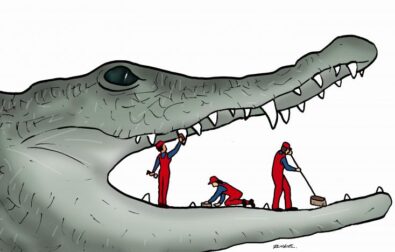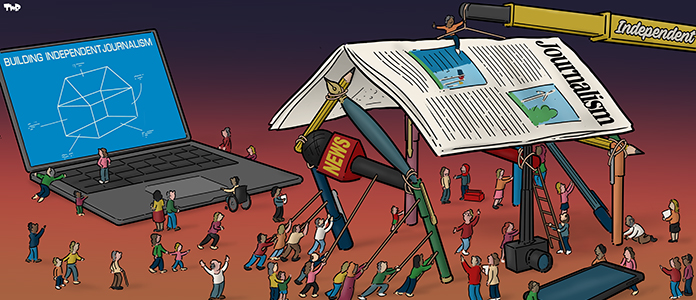In Italy, the news is generally reported by white journalists. It is a well-known and well-understood fact that holds true for every medium of news – television, radio and digital. But at the same time, it is tough to substantiate this phenomenon with data.
That is because the Italian news media suffers from a dearth of data on the state of the profession. Add to it the citizenship laws that favour the Italians and an overall failure of the country to recognize minorities, and you are left with a profession that is dominated by one race and one gender.
It’s not just about Italy
It is not just an Italian problem, to be sure; the lack of diversity in newsrooms is prevalent across the world. For instance, in 2020 in the UK, non-white journalists working in the news sector were at around 8%, even less than the overall workforce which was around 12%. Similarly, in Canada, almost 75% of the newsrooms were composed of white journalists between November 2020 and July 2021. In 2019 in the US, only 21.9% of the paid workforce in journalism identified as non-white; only 6.5% identified as Black.
The difference, though, is that in other countries, there is at least an ongoing debate on the subject. A lack of diverse voices in the news media is known to influence editorial approaches and discussions. In the US, these issues have attracted a lot of thought and debate over the years.
Interesting article?
It was made possible by Voxeurop’s community. High-quality reporting and translation comes at a cost. To continue producing independent journalism, we need your support.
In fact, it was cited as a problem in the US as early as 1972. Only 4.2% of the employees in the newspaper industry were Black, and of these, only 1.5% of reporters were Black. These numbers meant that at the height of the fight for civil rights for African Americans, the narrative in the media was being filtered through white “lenses”.
In Italy, there is very little discussion on the lack of diversity in the profession. The problem here is more complicated too. Given the lack of data, the subject of diversity in Italian news media becomes more anecdotal than it should be.
White men who explain and interpret the world
It is tough to explain the absence of second-generation Italian journalists through data. In 2019, foreigners residing in Italy represented 8.7% of the total population, or 5,250,000, according to data from the Italian National Institute of Statistics. Italy today has about 60 million inhabitants.
This ties into the Italian citizenship laws which are based on the principle ius sanguinis (blood right), fundamentally giving more rights to grandchildren and great-grandchildren of Italians born and raised abroad than to the children of migrants born and raised in Italy. That, coupled with the fact that the Italian census does not recognise minorities, makes it tough to substantiate the state of diversity in news media.
The narrative is almost always led by white men who explain and interpret the world in Italy – from the discussions on migration to changing the very exclusionary citizenship laws in the country
The few data points that are available come from the efforts of the Associazione Carta di Roma (Carta di Roma Association). The association was founded in 2011 “with the goal of implementing the Journalist’s Code of Conduct on immigration, signed by the National Council of Journalists (CNOG) and the National Federation of the Italian Press (FNSI) in June 2008”.
A 2020 report by Carta di Roma noted that people of foreign descent debated in the prime-time news in only 1% of the cases. Additionally, the Global Media Monitoring Project report noted that in 2020, in 90% of the cases, prime-time news broadcasts were presented by male anchors. Therefore, the narrative is almost always led by white men who explain and interpret the world in Italy – from the discussions on migration to changing the very exclusionary citizenship laws in the country– influencing perspectives of the masses and fueling fears.
As journalist Silvia Godano reports in Voci Globali, it is not easy to know how many second-generation journalists work in Italy: “When we talk about diversity in the Italian media, we mainly talk about gender equality and disability. Both RAI [Radiotelevisione italiana, the national public broadcasting company] and private publishing groups seem to have no strategies for diversity, neither in terms of recruitment and continuous training nor about programming”.
In Italy, second or third-generation journalists mostly appear in the news media only when they have to talk about their homeland or that of their parents, even when they have completely different academic backgrounds and specialisations. In a way, this is a practice to pigeonhole them – giving them limited space and restricting them to topics that can be termed as “theirs”, such as migration, citizenship reform, or the Black Lives Matter movement.
Oiza Q. Obasuyi is a junior researcher and program assistant at CILD human rights NGO. He focuses on human rights and is a contributor to various Italian media and tells The Fix Media: “One of the fundamental problems, in my opinion, concerns newsrooms. You cannot pretend to talk about diversity or inclusion if you do not take into account the fact that newsrooms remain ‘white’ and that often when we talk about issues where the people concerned are migrants, refugees, or Italian of foreign descent, they are excluded from the debate or from collaborating on the drafting of articles,” she says.
“The involvement of these people is crucial if we want to achieve a change in the media,” she adds. But there are enough and more hindrances standing in the way of that change.
Gatekeepers of Italian media
One of the major obstacles for non-white Italian journalists – as well as for white Italians who do not come from a privileged background – is access to the profession. In the country, news media is a path regulated by the Ordine dei Giornalisti (Order of Journalists), an institution whose roots date back to the years of fascism; its predecessor was founded in the 1920s to fundamentally regulate journalism.
In a way, the Order still operates as a gatekeeper, blocking many from accessing the profession. “We are the only European country that has the Order of Journalists, and to join it, as a professional or as a publicist, you need to make great sacrifices,” Leila Belhadj Mohamed, freelance journalist and podcaster tells The Fix Media. “To become a professional you need a Master’s [degree] that people from a migrant background cannot objectively afford.”
The sacrifices mentioned by Belhadj Mohamed include getting paid for journalistic work after months, and at very low pay rates compared to other European countries. “We have often complained about how certain contexts and communities are narrated, how this is done in a very superficial way, whether we are talking about news or geopolitics. In terms of the difficulties in accessing the world of information for people coming from a migrant background, I would add that it is also an extremely classist issue.”
“There is a generational issue because there is not a turn-over in newsrooms, a gender issue, a class issue, and the problem that sooner or later will have to lead to the necessary dismantlement of the Order. The Order has created an information lobby, turning this into a job for the wealthy, and it cannot be,” Belhadj Mohamed further adds.
Race, class, gender, age: the challenge for non-white voices in the Italian media is extremely intersectional
Adil Mauro, freelance journalist and podcaster, agrees. The lack of involvement of diverse voices has a direct influence on the kind of narratives that permeate the media, and it is an issue that is connected not only with race but also with class, Mauro tells The Fix Media. “I believe that the issue of diversity in Italian information is fundamentally a problem around class, it does not only affect people with a migrant background, but all people coming from a non-privileged class,” he says. “I believe that this is the one big obstacle, through coteries, bubbles, and closed circles. We are fundamentally talking about people who went to the same schools and universities, know each other, and are from a middle-upper or upper-class background because writing as a journalist is a luxury that few can afford, and people from a migrant background find it harder than others to afford this luxury.”
“Journalism and writing have a central political and social relevance, and the idea that it is only approachable for few people is something that hurts me deeply because people with a non-white gaze struggle to find space and are narrated badly by those who lack the background, empathy and the will to study and inform themselves,” Mauro further adds.
In this struggle to make space for diverse voices in Italian news, there are quite a few who are now standing up to the discrimination and starting to fight the good fight.
Things are moving
In recent times, more and more non-white voices have come up that are trying to find a space in the Italian media or create new spaces altogether.
The latest addition to such voices is DOTZ, an independent media company founded by video journalist Sara Lemlem. Lemlem and most of the current DOTZ newsroom met during a campaign called #cambieRAI (“change RAI”). The campaign was meant to criticise the public broadcaster for allowing the usage of the n-word [“negro” the Italian equivalent of “nigger” in English] in a programme without any qualms and against the norm of non-use of racist language in the media.
“That was a powerful moment in Italy, because the n-word had been used live on the public television [and nobody ever apologised for that, which] generated a very strong wave of indignation like I had never seen before in Italy,” Lemlem tells The Fix Media. “All of us (at DOTZ), even though I am the only Black person here, felt hit by the use of the n-word, and together with many other people, inside and outside Italy, we gathered online and built a collective response to RAI.”
From that campaign, the idea of DOTZ was developed, and, as Lemlem underlines, the newsroom can be fully dedicated to journalistic work, thanks to a grant from the European Cultural Fund. As women who do not belong to privileged backgrounds and cannot afford to work in the journalism sector without being paid, DOTZ benefited from this grant’s support.
“I think about editorial projects like DOTZ, Colory, [other media that can be mentioned are Griot Mag, Afroitalian Souls, and We Africans United] created by various people of different backgrounds and born to present a kind of information which adheres to the Italian reality, which despite what mainstream may tend to show, is not at all simply ‘white’,” says Obasuyi of CILD. “Young Italians have different backgrounds and do not recognise themselves in, or feel represented by Italian media. It is fundamental to pay attention to the new initiatives that arise from those who are systematically excluded from the debate that concerns them anyhow – if the aim is to change the situation,” Obasuyi further adds.
There are quite a few inspiring, up-and-coming stories of change in Italian media, but they are still far from making a significant impact. “We need to do more to encourage and support those diverse groups into journalism, promote alternative, non-graduate entry points and encourage employers to recruit from this talent pool,” Joanne Butcher, chief executive of the NCTJ said about the union’s report “Diversity in Journalism” in 2021. “Apprenticeships, foundation courses, and initiatives like the Community News Project are becoming even more important.”
Race, class, gender, age: the challenge for non-white voices in the Italian media is extremely intersectional, but what is certain is that the path towards establishing new spaces and taking back the narrative is open and now is being walked by many.












